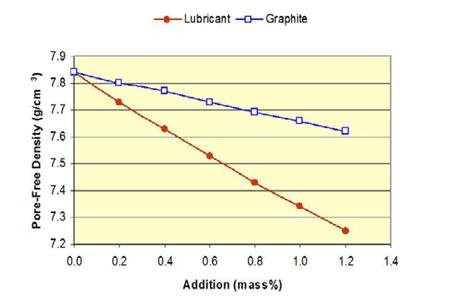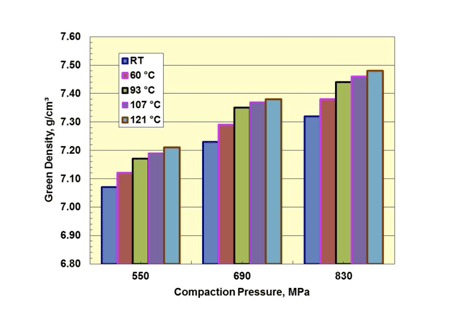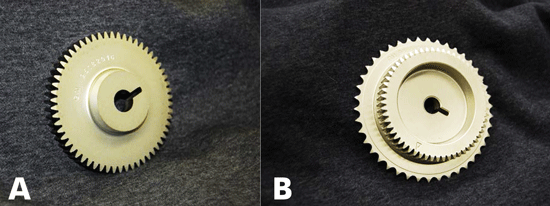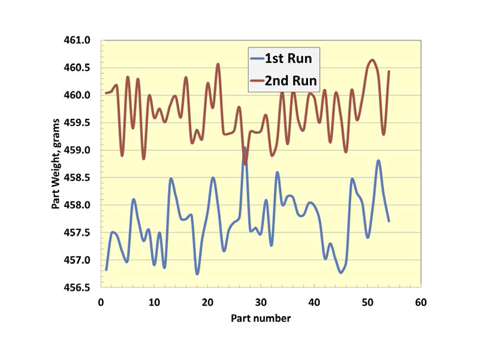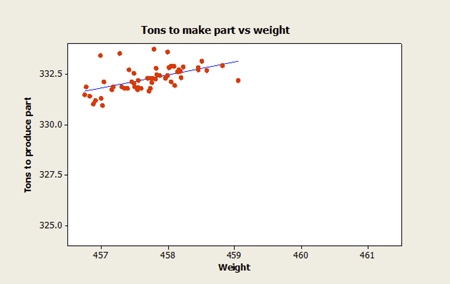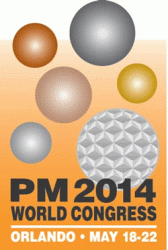PM2014 World Congress: Industrial scale verification of warm die compaction combined with the Hoeganaes ancormax 225 lubricant system
The recently developed AncorMax 225 lubricant can be used at addition levels as low as 0.25 wt%, in combination with warm die compaction with a part ejection temperature of 107°C (225°F), hence the suffix “225”. Use of this lubricant concept, together with a compaction pressure of 830 MPa (60 tsi), can offer green density levels in excess of 7.5 g/cm³.
Fig. 1 illustrates the benefit of reducing lubricant from the traditional 0.75 wt. % to 0.25 wt%; in this idealised data, the increase in pore free density is around 0.25 g/cm³. The combination of the use of the lower lubricant level with the exposure of the powder mass to increased temperatures up to ~150°C, in warm die compaction, delivers the required increase in green density. Fig. 2 shows the effects of raising the die temperature during the compaction of FLN2-4400 and illustrates that increasing the die temperature increases part density by softening the lubricant and consequently lowering interparticle and die wall friction.
The AncorMax 225 lubricant sytem has also been engineered to deliver, at the 0.25wt% addition level, equivalent ejection characteristics and superior green strength to those achieved at the 0.75 wt% addition level with commonly used PM lubricants.
Industrial experience with this lubricant system and forming approach was the subject of the paper “Production of High Density PM Automotive Components Utilizing Advanced Warm Die Compaction Technology” by Gregory Falleur and Suresh Shah (Cloyes Gear, USA) and Francis Hanejko and Sunil Patel (Hoeganaes Corporation, USA).
Cloyes Gear has utilised both warm compaction and warm die compaction to achieve higher part densities through single press/sinter techniques since the early 1990s and has now evaluated and initiated production utilising an AncorMax 225 premix for automotive valve train components. This paper described the manufacturing details and subsequent key production results.
Fig. 3 shows photographs of the components chosen for this study. Both parts were previously manufactured by PM using the warm compaction method (heated powder and heated die) with an ANCORDENSE 450 premix.
Both parts were produced, in these trials, from an FLN2-4400 with 0.35 wt% graphite and a total lubricant addition of 0.25 wt%. During production at Cloyes, the gears were evaluated for the following key characteristics: weight variability and press tonnage
Both parts were compacted on standard mechanical PM compaction equipment. The tools were modified to incorporate cartridge heating elements into the stress ring of the die. To measure the repeatability of the ‘bonded’ premix, multiple set-ups and production runs were completed to ensure product and press performance consistency.
The main gear (Fig. 3a) is compacted to ~7.2 g/cm³ density. In previous experience with the warm compaction route, nominal pressing force was 318 US tons (2830 kN).
Switching to the AncorMax 225 material resulted in an increase in total compaction force of ~8 to 14 US tons (2.5% to 4.4%). This increase in total compaction force was expected because of the reduced powder temperature of the AncorMax 225 relative to the ANCORDENSE 450 process. The consistency of the pressing tonnage part to part (Fig. 4) showed a maximum deviation of less than 1% over two distinct production trials, approximately four weeks apart using two distinct lots of premixed powder.
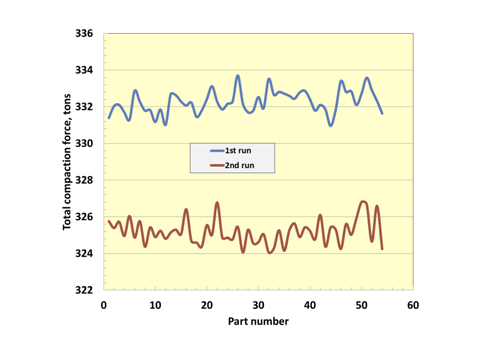
Fig. 4 Main running gear (Fig. 3a), total compaction tonnage from 2 distinct set-ups approximately 1 month apart [1]
The part weight consistencies from the two production runs are shown in Fig. 5. The total weight variation of both production runs was less than 2 g or approximately 0.5% total weight variation of the part. This translates to a maximum Cpk of ~1.9. Some improvement from the first run to the second run was observed. This can be attributed to the learning curve during production of both the raw material and the part.
Another key aspect of using warm die compaction was the ability to stop the compacting press during the production run without the need to re-establish steady state conditions. This characteristic promotes operational efficiency at the part production level.
Further improvements in part-to-part weight consistency are anticipated with additional operational experience and minor modifications to the filling cycle.
Fig. 6 shows the relationship between total compaction force and part weight for the main gear. As noted, this part has approximately 7.2 g/cm³ density and the relationship between pressing tonnage and part weight is nearly linear. This near linear relationship is a direct result of the reduced lubricant in the part giving higher pore free density. Consequently, minor variations in fill will not result in exponential increases in compaction loads and will reduce the potential for die damage and micro-laminations within the part from over-compaction.
The improvements in part weight and press tonnage control can be correlated with the more consistent powder properties of apparent density and flow. Roughly similar conclusions were drawn from the production trials on the large “spro” gear.
Another key characteristic necessary for the conversion from warm compaction to warm die compaction was the need to maintain good surface finish. In the trials at Hoeganaes, the ejection characteristics of the AncorMax 225 were equivalent or superior to the ANCORDENSE 450. This laboratory experience was replicated in the production trials at Cloyes.
As a final note, a modification to the premix composition was necessary to utilise the existing dies (the modifications still met the MPIF standard for FLN2-4400). The AncorMax 225 material exhibited higher growth than the replaced ANCORDENSE 450 premix. Exact reasons for this difference were not determined and are under investigation.
References
[1] Gregory Falleur et al. Production of High Density PM Automotive Components Utilizing Advanced Warm Die Compaction Technology, as presented at PM2014 World Congress, MPIF, USA
Author
Dr David Whittaker is a consultant to the Powder Metallurgy and associated industries. Contact +44 1902 338498 email: [email protected]
PM2014 World Congress
The 2014 World Congress on Powder Metallurgy and Particulate Materials was organised by the Metal Powder Industries Federation. For more information please visit the MPIF website: www.mpif.org



